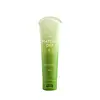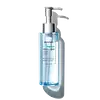What's inside
What's inside
 Key Ingredients
Key Ingredients

 Benefits
Benefits

 Concerns
Concerns

 Ingredients Side-by-side
Ingredients Side-by-side

Water
Skin ConditioningPotassium Cocoyl Hydrolyzed Collagen
Skin ConditioningGlycerin
HumectantAcrylates Copolymer
Cocamidopropyl Betaine
CleansingPotassium Cocoyl Glycinate
Butylene Glycol
HumectantDecyl Glucoside
CleansingPEG-120 Methyl Glucose Dioleate
EmulsifyingPentylene Glycol
Skin ConditioningXanthan Gum
EmulsifyingAvena Sativa Kernel Extract
AbrasivePanthenol
Skin ConditioningGlycyrrhiza Glabra Leaf Extract
Skin ConditioningTriethanolamine
BufferingClitoria Ternatea Flower Extract
Skin Conditioning1,2-Hexanediol
Skin ConditioningHouttuynia Cordata Extract
Skin ConditioningSodium Hyaluronate
HumectantEthylhexylglycerin
Skin ConditioningCinnamomum Zeylanicum Bark Extract
AntimicrobialCapryloyl Glycine
CleansingSarcosine
Skin ConditioningCitrus Junos Seed Extract
AntioxidantCitrus Unshiu Peel Extract
MaskingActinidia Chinensis Seed
AbrasiveSalicylic Acid 0.01%
MaskingFragaria Chiloensis Fruit Extract
Skin ConditioningVitis Vinifera Seed Extract
AntimicrobialVitis Vinifera Skin Extract
AntioxidantVitis Vinifera Leaf Extract
Skin ConditioningGarcinia Mangostana Peel Extract
Skin ConditioningPropanediol
SolventSodium Hydroxide
BufferingDipotassium Glycyrrhizate
HumectantChlorphenesin
AntimicrobialAllantoin
Skin ConditioningDisodium EDTA
Camellia Sinensis Leaf
PerfumingWater, Potassium Cocoyl Hydrolyzed Collagen, Glycerin, Acrylates Copolymer, Cocamidopropyl Betaine, Potassium Cocoyl Glycinate, Butylene Glycol, Decyl Glucoside, PEG-120 Methyl Glucose Dioleate, Pentylene Glycol, Xanthan Gum, Avena Sativa Kernel Extract, Panthenol, Glycyrrhiza Glabra Leaf Extract, Triethanolamine, Clitoria Ternatea Flower Extract, 1,2-Hexanediol, Houttuynia Cordata Extract, Sodium Hyaluronate, Ethylhexylglycerin, Cinnamomum Zeylanicum Bark Extract, Capryloyl Glycine, Sarcosine, Citrus Junos Seed Extract, Citrus Unshiu Peel Extract, Actinidia Chinensis Seed, Salicylic Acid 0.01%, Fragaria Chiloensis Fruit Extract, Vitis Vinifera Seed Extract, Vitis Vinifera Skin Extract, Vitis Vinifera Leaf Extract, Garcinia Mangostana Peel Extract, Propanediol, Sodium Hydroxide, Dipotassium Glycyrrhizate, Chlorphenesin, Allantoin, Disodium EDTA, Camellia Sinensis Leaf
Water
Skin ConditioningPotassium Cocoyl Glycinate
Panthenol
Skin ConditioningPotassium Cocoate
EmulsifyingAcrylates/Steareth-20 Methacrylate Crosspolymer
Sodium Lauroamphoacetate
CleansingCentella Asiatica Extract
CleansingGlycerin
HumectantDecyl Glucoside
CleansingCeramide NP
Skin ConditioningCeramide Ns
Skin ConditioningCeramide As
Skin ConditioningCeramide EOP
Skin ConditioningCeramide AP
Skin ConditioningSodium Polyaspartate
HumectantButylene Glycol
HumectantPentylene Glycol
Skin ConditioningPropanediol
SolventMethyl Diisopropyl Propionamide
MaskingEthyl Menthane Carboxamide
TonicMenthyl Lactate
MaskingHydroxypropylcellulose
EmulsifyingIsopropyl Palmitate
EmollientTrehalose
HumectantSerine
MaskingAlgin
MaskingCaprylyl Glycol
EmollientSodium Hyaluronate
HumectantPullulan
Disodium Phosphate
BufferingPotassium Phosphate
BufferingHydrogenated Lecithin
EmulsifyingPolyglyceryl-10 Stearate
Skin ConditioningEthylhexylglycerin
Skin ConditioningWater, Potassium Cocoyl Glycinate, Panthenol, Potassium Cocoate, Acrylates/Steareth-20 Methacrylate Crosspolymer, Sodium Lauroamphoacetate, Centella Asiatica Extract, Glycerin, Decyl Glucoside, Ceramide NP, Ceramide Ns, Ceramide As, Ceramide EOP, Ceramide AP, Sodium Polyaspartate, Butylene Glycol, Pentylene Glycol, Propanediol, Methyl Diisopropyl Propionamide, Ethyl Menthane Carboxamide, Menthyl Lactate, Hydroxypropylcellulose, Isopropyl Palmitate, Trehalose, Serine, Algin, Caprylyl Glycol, Sodium Hyaluronate, Pullulan, Disodium Phosphate, Potassium Phosphate, Hydrogenated Lecithin, Polyglyceryl-10 Stearate, Ethylhexylglycerin
 Reviews
Reviews

Ingredients Explained
These ingredients are found in both products.
Ingredients higher up in an ingredient list are typically present in a larger amount.
Butylene Glycol (or BG) is used within cosmetic products for a few different reasons:
Overall, Butylene Glycol is a safe and well-rounded ingredient that works well with other ingredients.
Though this ingredient works well with most skin types, some people with sensitive skin may experience a reaction such as allergic rashes, closed comedones, or itchiness.
Learn more about Butylene GlycolDecyl Glucoside is a glucose-based surfactant and emulsion stabilizer. It is created by reacting glucose with the fatty acids from plants.
Surfactants help clean the skin by trapping oil, sebum, and dirt to be washed away. As an emulsion stabilizer, it stabilizes the ingredients in a product by preventing them from separating.
This ingredient is biodegradable and non-toxic. This ingredient is commonly found in baby shampoos.
Decyl Glucoside is sometimes used to stabilize the UV filter Tinosorb.
Learn more about Decyl GlucosideEthylhexylglycerin (we can't pronounce this either) is commonly used as a preservative and skin softener. It is derived from glyceryl.
You might see Ethylhexylglycerin often paired with other preservatives such as phenoxyethanol. Ethylhexylglycerin has been found to increase the effectiveness of these other preservatives.
Glycerin is already naturally found in your skin. It helps moisturize and protect your skin.
A study from 2016 found glycerin to be more effective as a humectant than AHAs and hyaluronic acid.
As a humectant, it helps the skin stay hydrated by pulling moisture to your skin. The low molecular weight of glycerin allows it to pull moisture into the deeper layers of your skin.
Hydrated skin improves your skin barrier; Your skin barrier helps protect against irritants and bacteria.
Glycerin has also been found to have antimicrobial and antiviral properties. Due to these properties, glycerin is often used in wound and burn treatments.
In cosmetics, glycerin is usually derived from plants such as soybean or palm. However, it can also be sourced from animals, such as tallow or animal fat.
This ingredient is organic, colorless, odorless, and non-toxic.
Glycerin is the name for this ingredient in American English. British English uses Glycerol/Glycerine.
Learn more about GlycerinPanthenol is a common ingredient that helps hydrate and soothe the skin. It is found naturally in our skin and hair.
There are two forms of panthenol: D and L.
D-panthenol is also known as dexpanthenol. Most cosmetics use dexpanthenol or a mixture of D and L-panthenol.
Panthenol is famous due to its ability to go deeper into the skin's layers. Using this ingredient has numerous pros (and no cons):
Like hyaluronic acid, panthenol is a humectant. Humectants are able to bind and hold large amounts of water to keep skin hydrated.
This ingredient works well for wound healing. It works by increasing tissue in the wound and helps close open wounds.
Once oxidized, panthenol converts to pantothenic acid. Panthothenic acid is found in all living cells.
This ingredient is also referred to as pro-vitamin B5.
Learn more about PanthenolPentylene glycol is typically used within a product to thicken it. It also adds a smooth, soft, and moisturizing feel to the product. It is naturally found in plants such as sugar beets.
The hydrophilic trait of Pentylene Glycol makes it a humectant. As a humectant, Pentylene Glycol helps draw moisture from the air to your skin. This can help keep your skin hydrated.
This property also makes Pentylene Glycol a great texture enhancer. It can also help thicken or stabilize a product.
Pentylene Glycol also acts as a mild preservative and helps to keep a product microbe-free.
Some people may experience mild eye and skin irritation from Pentylene Glycol. We always recommend speaking with a professional about using this ingredient in your routine.
Pentylene Glycol has a low molecular weight and is part of the 1,2-glycol family.
Learn more about Pentylene GlycolPotassium Cocoyl Glycinate is an amino acid-based surfactant and cleaning agent. This ingredient can be derived from animals or plants. It may also be synthetically created from fatty acids of the coconut and glycine.
Potassium Cocoyl Glycinate is a gentle surfactant. Surfactants help gather the dirt, oil, and other pollutants from your skin to be rinsed away. It is a mild cleanser and naturally produces foam.
Propanediol is an all-star ingredient. It softens, hydrates, and smooths the skin.
It’s often used to:
Propanediol is not likely to cause sensitivity and considered safe to use. It is derived from corn or petroleum with a clear color and no scent.
Learn more about PropanediolSodium Hyaluronate is hyaluronic acid's salt form. It is commonly derived from the sodium salt of hyaluronic acid.
Like hyaluronic acid, it is great at holding water and acts as a humectant. This makes it a great skin hydrating ingredient.
Sodium Hyaluronate is naturally occurring in our bodies and is mostly found in eye fluid and joints.
These are some other common types of Hyaluronic Acid:
Learn more about Sodium HyaluronateWater. It's the most common cosmetic ingredient of all. You'll usually see it at the top of ingredient lists, meaning that it makes up the largest part of the product.
So why is it so popular? Water most often acts as a solvent - this means that it helps dissolve other ingredients into the formulation.
You'll also recognize water as that liquid we all need to stay alive. If you see this, drink a glass of water. Stay hydrated!
Learn more about Water